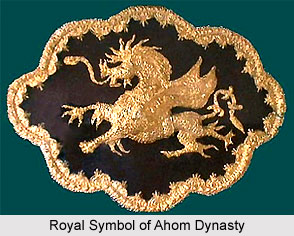 Gobar Roja was an Ahom king who ruled over the kingdom for about three weeks in the period of 1675 to 1675 AD. He was the first representative of the Tungkhungia line of Ahom dynasty. He was crowned as the king by one of the most powerful officers of Ahom kingdom, Debera Borbarua. He was the last king who was crowned by Debera Borbarua, after which both were executed by the Ahom officers of Saraighatia under the commandership of Atan Burhagohain.
Gobar Roja was an Ahom king who ruled over the kingdom for about three weeks in the period of 1675 to 1675 AD. He was the first representative of the Tungkhungia line of Ahom dynasty. He was crowned as the king by one of the most powerful officers of Ahom kingdom, Debera Borbarua. He was the last king who was crowned by Debera Borbarua, after which both were executed by the Ahom officers of Saraighatia under the commandership of Atan Burhagohain.
Coronation of Gobar Roja
Gobar Roja was born to Saranga Gohain. Tungkhungia line of this dynasty was founded by his grandfather Suteng Namrupia Raja. The last few Ahom kings belonged to this lineage. In 1672, when Udayaditya Singha was executed, the kingdom experienced a set back with the advent of weak kings in the kingdom. Some of the prominent minister attained great power during this era namely Atan Burhgohain, Debera Barbarua, Laluk Sola Borphukan. After the execution of three successive kings Debera Barbarua installed Gobar Roja on the throne and attained dictatorial power.
Atrocities of Debera Barbarua
During the reign of Gobar Roja, Debera Barbarua commanded a number of cold murders and thus captured the capitals of his rivals. However the most powerful nobles of the kingdom were positioned at Guwahati. Later Debera on the alleged orders of the king sent his agent Lao Deka there to summon some of the nobles to the capital Garhgaon. When the nobles reached the capital they were further taken to Laotoli and were killed.
Expedition against Debera Barbarua
Debera Barbarua also planned to kill Atan Burhagohain and Laluk Sola Borphukan to safeguard his future position. They were thus summoned to the capital but the son of the Burhagohain warned his father about the conspiracies of Debera Barbarua. He also informed him not to follow the royal orders, as they were not from the king but from Debera. His son also informed the Burhagohain about the execution of other nobles who were called from Guwahati to the capital. This was followed by a consultation among the officers about the misdeeds of Debera Barbarua and all the officers thus pledged to battle against the corrupt minister.
An expedition started in April 1675 under the leadership of Atan Burhagohain from Guwahati which proceeded by both land and water. During that time Debera Borbarua was dwelling near the temple of Chomdeo, along with his wives. When he heard about the upcoming expedition, he left his residence and to mark the beginning of the battle beheaded the brother of Laluk Sola Borphukan, Lao Deka, at the entrance of the capital. Anticipating the power of army in the expedition, the army of Debera Borbarua left him along with Chengmung Borgohain, his nephew, who joined the camp of Atan Burhagohain. Subsequently Debera was arrested and was severely insulted. Later at Rajahat he was killed by being hoed from head to foot.
Death of Gobar Roja
Throughout the expedition, Gobar Roja was confined at Haithaguri. After the execution of Debera Borbarua, consultation was held among the nobles with Atan Burhagohain where the nobles expressed their desire of installing him as the king. Atan Burhagohain however refused the proposal and declared that only the members of royal dynasty are eligible of ruling the kingdom. He thus nominated Arjun Konwar, a prince from Namrupia branch of Ahom dynasty for becoming the king. On consultation with other nobles, Gobar Roja was then sent to a place known as Bhogbari and was killed there on 23rd of May 1675.



















